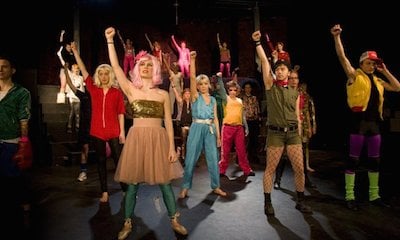Parallel Lives: Marlow Moss 1889-1958
September 22, 2014
[Image: Marlow Moss, ‘Balanced Forms in Gunmetal on Cornish Granite’, 1956-57. Reinforced metal and granite. Courtesy of The Tate]
Leeds Art Gallery
6th June – 7th September 2014
Having admittedly struggled throughout my previous encounters with this show, I ventured forth following a brief holiday, with fresh eyes and a rested mind for my third visit to the exhibition of Marlow Moss at Leeds Art Gallery. As I approached however, I noticed a hive of bustling activity taking place in the open area directly outside the gallery. Under the watchful eye of Thomas Houseago’s monumental striding figure, unfolded an enlightening event celebrating children’s right to play. Using wide-ranging materials (this was no pritt stick and paper debacle!) dozens of excitable children (and adults alike) joined in the joyous process of making, and the construction of what appeared to be developing into some sort of interventional village. Cardboard houses and buildings of all sizes, shapes and character- some well over seven feet- stood proud among the crowds, all personalised and embellished accordingly. It was not only warming to see people so submerged in their own creative endeavours, but also and perhaps more interestingly, the way in which it (both individual ‘pieces’ and the event more collectively) captivated a constant yet considerably varied and continually changing secondary audience as the public passed through the area.
I couldn’t help but call to mind the early sentiments of constructivism with which Moss is associated, as I watched menial materials- cardboard, wood, paper, tape etc reincarnate themselves as delightfully whimsical and charming structures. Such an emphasis on materiality, or more specifically materials used in industry such as wood metal and glass, can be traced back to Vladimir Tatlin (1885-1953), and his inspiration following a visit to Picasso’s studio in 1914 to transform the painterly surfaces of cubism into ‘real materials in real space’. Tatlin’s work swiftly developed into wall-mounted ‘painted reliefs’, employing materials that would project out from the surface.
Considerably overlooked throughout her career, Marlow Moss changed her name and permanently adopted a masculine appearance in 1919. Based between Paris and Cornwall for much of her life, her work examines a gestural negotiation of space, movement and light. The show undeniably delivers in that it displays a considerable range of her work, including paintings, such as White Yellow Black (1953) which attracted the attention of Piet Mondrian (1872-1944, perhaps mistaking it for his own) with her contribution of the double black line to the neo-plastic agenda which he orchestrated. It is suggested that the double line arrangement augments the dynamism of her compositions, but in many ways it seems to add a heightened element of heaviness and laboured rigidity, suggestive of a fence, or the supporting lines of a railway track- a further sense of structure and unfailing stillness. Relief works are a welcome feature, along with some sculptural highlights including the trophy-esque Linear Construction (1956-7), a wonderfully handsome arrangement of interlocking steel on two aluminium bases. The exhibition is also supported by a selection of letters and photographs taken from the Tate archive.
Although despite the satisfaction of seeing such a significant and enigmatic figure rise to wider exposure, something seems off centre. Having been greeted at the entrance of the show by the quote “I am no painter, I don’t see form, I only see space, movement and light”, it is surprising to be faced with so many paintings- a discipline that dominated much of her early career. It is simultaneously thought-provoking (unhinged and contradictory notions have for long been instrumental driving forces within post-modernist art practice) yet also moderately undoing that she has employed the medium of paint though which to express her stated preoccupation with space movement and light rather than form. Whilst it is not perhaps the paintings that are the focus, but the aforementioned dynamics that are investigated within them, this feels far more realised and effective within her three-dimensional work. In this manner, the paintings felt very rather preparatory.
Having enjoyed the events outside in relation to constructivism and the albeit naively utopian notion of cementing a bond with the working class through materiality, I found that despite its deeply investigative and exploratory agenda, the work inside felt somewhat reserved and confined to itself. Recalling the political divisions which occurred within constructivist practice throughout the early 1920s which (very generally) divided artists into those who believed in maintaining a personal involvement, and those who concluded that artists should be ‘intellectual workers’, I found Moss difficult to place.
The overall reserved flavour of the exhibition was enhanced further by the incredibly library-esque architectural structure of the gallery space itself along with the faint clinking and clanking of mugs from the cafe area, which coupled with the above concerns brought about more of a project space environment or open studio/sketchbook display (the works were surprisingly small) than a cohesive exhibition. This needless to say is not categorically problematic, but as not quite one or the other, the work felt marginally unsettled. Marlow Moss is most assuredly an enlightening and interesting exhibition, and certainly worth visiting as an undeniably influential chapter in British art- but is it exciting? Well… no.
Somewhat different though inextricably linked was Conversations around Marlow Moss at the &Model Gallery (12th June – 18th July), just across the road from Leeds Art Galley. The exhibition consisted of a speculative dialogue between the exhibitors’ work and that of the repressed and ambiguous Moss, and also coincided with two exhibitions of Mondrian at Tate Liverpool and the Turner Contemporary. Spanning three floors and curated by Andrew Bick and Katrina Blannin, Conversations around Marlow Moss presented British Construction and Systems artists in a conversational interrogation into what they stress are far from redundant modes of practice. In so doing, the work places Moss in a fresh dialogue with post-modernist sentiments as a means to continue to enjoy and celebrate Moss’ career alongside her successors today. The show boasts far more character than that of Leeds Art Gallery, encompassing intriguing two dimensional works alongside a wide ranging sculptural discourse, incorporating ceramics, wood, linen, perspex, aluminium light boxes, steel, brass, felt, hessian, wax, oil, watercolour and so forth. Although similarly frustrating with regards to its seemingly impenetrable formal austerity and nagging stillness, the show offers an absorbingly remastered discussion of constructivist tendencies, which fittingly contextualises and in many ways amplifies the work across the road.
Dan Newton




Comments